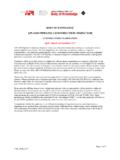Transcription of NEW RULE EFFECTIVE NOVEMBER 8, 2010 OSHA 29 CFR Part …
1 NEW RULE EFFECTIVE NOVEMBER 8, 2010 osha 29 CFR part hoisting personnel part Number, Title: 1926, Safety And Health Regulations For Construction Subpart, Title: CC, Cranes & Derricks in Construction Standard Number, Title: , hoisting PersonnelThe requirements of this section are supplemental to the other requirements in this subpart and apply when one or more employees are hoisted. (a) The use of equipment to hoist employees is prohibited except where the employer demonstrates that the erection, use, and dismantling of conventional means of reaching the work area, such as a personnel hoist, ladder, stairway, aerial lift, elevating work platform, or scaffold, would be more hazardous, or is not possible because of the project's structural design or worksite conditions.
2 This paragraph does not apply to work covered by subpart R (Steel Erection) of this part . (b) Use of personnel platform. (b)(1) When using equipment to hoist employees, the employees must be in a personnel platform that meets the requirements of paragraph (e) of this section. (b)(2) Exceptions: A personnel platform is not required for hoisting employees: (b)(2)(i) Into and out of drill shafts that are up to and including 8 feet in diameter (see paragraph (o) of this section for requirements for hoisting these employees). (b)(2)(ii) In pile driving operations (see paragraph (p) of this section for requirements for hoisting these employees).
3 (b)(2)(iii) Solely for transfer to or from a marine worksite in a marine hoisted personnel transfer device (see paragraph (r) of this section for requirements for hoisting these employees). (b)(2)(iv) In storage tank (steel or concrete), shaft and chimney operations (see paragraph (s) of this section for requirements for hoisting these employees). (c) Equipment set up. (c)(1) The equipment must be uniformly level, within one percent of level grade, and located on footing that a qualified person has determined to be sufficiently firm and stable.
4 (c)(2) Equipment with outriggers or stabilizers must have them all extended and locked. The amount of extension must be the same for all outriggers and stabilizers and in accordance with manufacturer procedures and load charts. (d) Equipment criteria. (d)(1) Capacity: Use of suspended personnel platforms. The total load (with the platform loaded, including the hook, load line and rigging) must not exceed 50 percent of the rated capacity for the radius and configuration of the equipment, except during proof testing. (d)(2) Capacity: Use of boom attached personnel platforms.
5 The total weight of the loaded personnel platform must not exceed 50 percent of the rated capacity for the radius and configuration of the equipment (except during proof testing). (d)(3) Capacity: hoisting personnel without a personnel platform. When hoisting personnel without a personnel platform pursuant to paragraph (b)(2) of this section, the total load (including the hook, load line, rigging and any other equipment that imposes a load) must not exceed 50 percent of the rated capacity for the radius and configuration of the equipment, except during proof testing.
6 (d)(4) When the occupied personnel platform is in a stationary working position, the load and boom hoist brakes, swing brakes, and operator actuated secondary braking and locking features (such as pawls or dogs) or automatic secondary brakes must be engaged. (d)(5) Devices. (d)(5)(i) Equipment (except for derricks and articulating cranes) with a variable angle boom must be equipped with all of the following: (d)(5)(i)(A) A boom angle indicator, readily visible to the operator, and (d)(5)(i)(B) A boom hoist limiting device.
7 (d)(5)(ii) Articulating cranes must be equipped with a properly functioning automatic overload protection device. (d)(5)(iii) Equipment with a luffing jib must be equipped with: (d)(5)(iii)(A) A jib angle indicator, readily visible to the operator, and. (d)(5)(iii)(B) A jib hoist limiting device. (d)(5)(iv) Equipment with telescoping booms must be equipped with a device to indicate the boom's extended length clearly to the operator, or must have measuring marks on the boom. (d)(5)(v) Anti two block. A device which automatically prevents damage and load failure from contact between the load block, overhaul ball, or similar component, and the boom tip (or fixed upper block or similar component) must be used.
8 The device(s) must prevent such damage/failure at all points where two blocking could occur. Exception: This device is not required when hoisting personnel in pile driving operations. Instead, paragraph (p)(2) of this section specifies how to prevent two blocking during such operations. (d)(5)(vi) Controlled load lowering. The load line hoist drum must have a system, other than the load line hoist brake, which regulates the lowering rate of speed of the hoist mechanism. This system or device must be used when hoisting personnel . Note: Free fall of the load line hoist is prohibited (see (d); the use of equipment in which the boom hoist mechanism can free fall is also prohibited (see (a)(1).))
9 (d)(5)(vii) Proper operation required. personnel hoisting operations must not begin unless the devices listed in this section are in proper working order. If a device stops working properly during such operations, the operator must safely stop operations. personnel hoisting operations must not resume until the device is again working properly. Alternative measures are not permitted. (See for tag out and related requirements.) (d)(6) Direct attachment of a personnel platform to a luffing jib is prohibited. (e) personnel platform criteria.
10 (e)(1) A qualified person familiar with structural design must design the personnel platform and attachment/suspension system used for hoisting personnel . (e)(2) The system used to connect the personnel platform to the equipment must allow the platform to remain within 10 degrees of level, regardless of boom angle. (e)(3) The suspension system must be designed to minimize tipping of the platform due to movement of employees occupying the platform. (e)(4) The personnel platform itself (excluding the guardrail system and personal fall arrest system anchorages), must be capable of supporting, without failure, its own weight and at least five times the maximum intended load.


